Chris Donahue
Aligning Text-to-Music Evaluation with Human Preferences
Mar 20, 2025Abstract:Despite significant recent advances in generative acoustic text-to-music (TTM) modeling, robust evaluation of these models lags behind, relying in particular on the popular Fr\'echet Audio Distance (FAD). In this work, we rigorously study the design space of reference-based divergence metrics for evaluating TTM models through (1) designing four synthetic meta-evaluations to measure sensitivity to particular musical desiderata, and (2) collecting and evaluating on MusicPrefs, the first open-source dataset of human preferences for TTM systems. We find that not only is the standard FAD setup inconsistent on both synthetic and human preference data, but that nearly all existing metrics fail to effectively capture desiderata, and are only weakly correlated with human perception. We propose a new metric, the MAUVE Audio Divergence (MAD), computed on representations from a self-supervised audio embedding model. We find that this metric effectively captures diverse musical desiderata (average rank correlation 0.84 for MAD vs. 0.49 for FAD and also correlates more strongly with MusicPrefs (0.62 vs. 0.14).
Hookpad Aria: A Copilot for Songwriters
Feb 12, 2025Abstract:We present Hookpad Aria, a generative AI system designed to assist musicians in writing Western pop songs. Our system is seamlessly integrated into Hookpad, a web-based editor designed for the composition of lead sheets: symbolic music scores that describe melody and harmony. Hookpad Aria has numerous generation capabilities designed to assist users in non-sequential composition workflows, including: (1) generating left-to-right continuations of existing material, (2) filling in missing spans in the middle of existing material, and (3) generating harmony from melody and vice versa. Hookpad Aria is also a scalable data flywheel for music co-creation -- since its release in March 2024, Aria has generated 318k suggestions for 3k users who have accepted 74k into their songs. More information about Hookpad Aria is available at https://www.hooktheory.com/hookpad/aria
VERSA: A Versatile Evaluation Toolkit for Speech, Audio, and Music
Dec 23, 2024Abstract:In this work, we introduce VERSA, a unified and standardized evaluation toolkit designed for various speech, audio, and music signals. The toolkit features a Pythonic interface with flexible configuration and dependency control, making it user-friendly and efficient. With full installation, VERSA offers 63 metrics with 711 metric variations based on different configurations. These metrics encompass evaluations utilizing diverse external resources, including matching and non-matching reference audio, text transcriptions, and text captions. As a lightweight yet comprehensive toolkit, VERSA is versatile to support the evaluation of a wide range of downstream scenarios. To demonstrate its capabilities, this work highlights example use cases for VERSA, including audio coding, speech synthesis, speech enhancement, singing synthesis, and music generation. The toolkit is available at https://github.com/shinjiwlab/versa.
Vision Language Models Are Few-Shot Audio Spectrogram Classifiers
Nov 18, 2024Abstract:We demonstrate that vision language models (VLMs) are capable of recognizing the content in audio recordings when given corresponding spectrogram images. Specifically, we instruct VLMs to perform audio classification tasks in a few-shot setting by prompting them to classify a spectrogram image given example spectrogram images of each class. By carefully designing the spectrogram image representation and selecting good few-shot examples, we show that GPT-4o can achieve 59.00% cross-validated accuracy on the ESC-10 environmental sound classification dataset. Moreover, we demonstrate that VLMs currently outperform the only available commercial audio language model with audio understanding capabilities (Gemini-1.5) on the equivalent audio classification task (59.00% vs. 49.62%), and even perform slightly better than human experts on visual spectrogram classification (73.75% vs. 72.50% on first fold). We envision two potential use cases for these findings: (1) combining the spectrogram and language understanding capabilities of VLMs for audio caption augmentation, and (2) posing visual spectrogram classification as a challenge task for VLMs.
Local deployment of large-scale music AI models on commodity hardware
Nov 14, 2024Abstract:We present the MIDInfinite, a web application capable of generating symbolic music using a large-scale generative AI model locally on commodity hardware. Creating this demo involved porting the Anticipatory Music Transformer, a large language model (LLM) pre-trained on the Lakh MIDI dataset, to the Machine Learning Compilation (MLC) framework. Once the model is ported, MLC facilitates inference on a variety of runtimes including C++, mobile, and the browser. We envision that MLC has the potential to bridge the gap between the landscape of increasingly capable music AI models and technology more familiar to music software developers. As a proof of concept, we build a web application that allows users to generate endless streams of multi-instrumental MIDI in the browser, either from scratch or conditioned on a prompt. On commodity hardware (an M3 Macbook Pro), our demo can generate 51 notes per second, which is faster than real-time playback for 72.9% of generations, and increases to 86.3% with 2 seconds of upfront buffering.
Just Label the Repeats for In-The-Wild Audio-to-Score Alignment
Nov 11, 2024Abstract:We propose an efficient workflow for high-quality offline alignment of in-the-wild performance audio and corresponding sheet music scans (images). Recent work on audio-to-score alignment extends dynamic time warping (DTW) to be theoretically able to handle jumps in sheet music induced by repeat signs-this method requires no human annotations, but we show that it often yields low-quality alignments. As an alternative, we propose a workflow and interface that allows users to quickly annotate jumps (by clicking on repeat signs), requiring a small amount of human supervision but yielding much higher quality alignments on average. Additionally, we refine audio and score feature representations to improve alignment quality by: (1) integrating measure detection into the score feature representation, and (2) using raw onset prediction probabilities from a music transcription model instead of piano roll. We propose an evaluation protocol for audio-to-score alignment that computes the distance between the estimated and ground truth alignment in units of measures. Under this evaluation, we find that our proposed jump annotation workflow and improved feature representations together improve alignment accuracy by 150% relative to prior work (33% to 82%).
Do Music Generation Models Encode Music Theory?
Oct 01, 2024



Abstract:Music foundation models possess impressive music generation capabilities. When people compose music, they may infuse their understanding of music into their work, by using notes and intervals to craft melodies, chords to build progressions, and tempo to create a rhythmic feel. To what extent is this true of music generation models? More specifically, are fundamental Western music theory concepts observable within the "inner workings" of these models? Recent work proposed leveraging latent audio representations from music generation models towards music information retrieval tasks (e.g. genre classification, emotion recognition), which suggests that high-level musical characteristics are encoded within these models. However, probing individual music theory concepts (e.g. tempo, pitch class, chord quality) remains under-explored. Thus, we introduce SynTheory, a synthetic MIDI and audio music theory dataset, consisting of tempos, time signatures, notes, intervals, scales, chords, and chord progressions concepts. We then propose a framework to probe for these music theory concepts in music foundation models (Jukebox and MusicGen) and assess how strongly they encode these concepts within their internal representations. Our findings suggest that music theory concepts are discernible within foundation models and that the degree to which they are detectable varies by model size and layer.
The Impact of Element Ordering on LM Agent Performance
Sep 19, 2024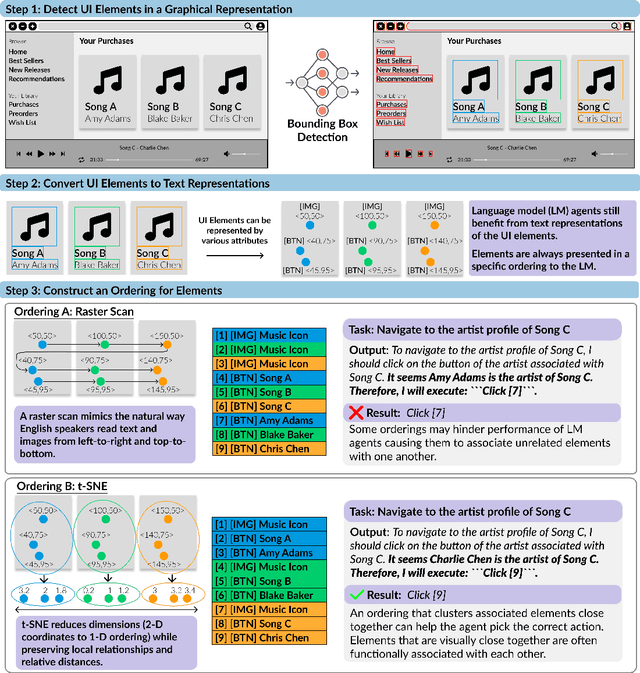

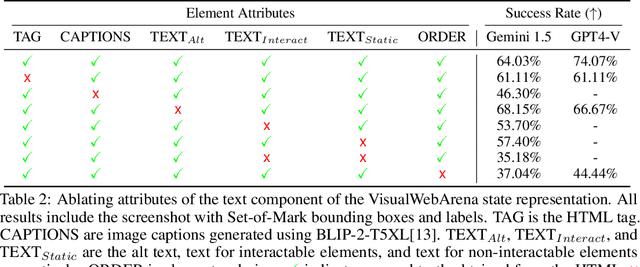
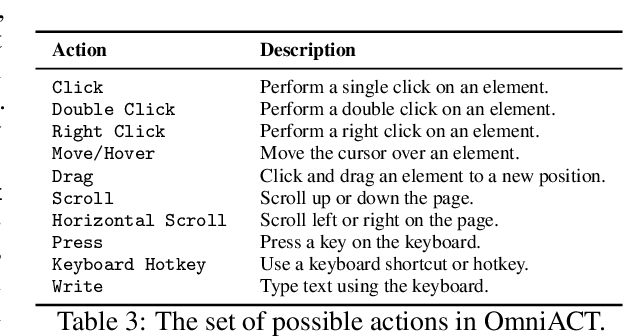
Abstract:There has been a surge of interest in language model agents that can navigate virtual environments such as the web or desktop. To navigate such environments, agents benefit from information on the various elements (e.g., buttons, text, or images) present. It remains unclear which element attributes have the greatest impact on agent performance, especially in environments that only provide a graphical representation (i.e., pixels). Here we find that the ordering in which elements are presented to the language model is surprisingly impactful--randomizing element ordering in a webpage degrades agent performance comparably to removing all visible text from an agent's state representation. While a webpage provides a hierarchical ordering of elements, there is no such ordering when parsing elements directly from pixels. Moreover, as tasks become more challenging and models more sophisticated, our experiments suggest that the impact of ordering increases. Finding an effective ordering is non-trivial. We investigate the impact of various element ordering methods in web and desktop environments. We find that dimensionality reduction provides a viable ordering for pixel-only environments. We train a UI element detection model to derive elements from pixels and apply our findings to an agent benchmark--OmniACT--where we only have access to pixels. Our method completes more than two times as many tasks on average relative to the previous state-of-the-art.
Foundation Models for Music: A Survey
Aug 27, 2024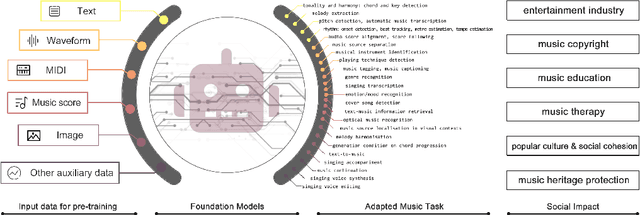
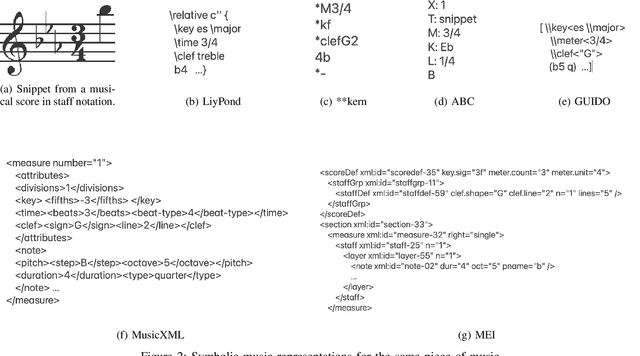
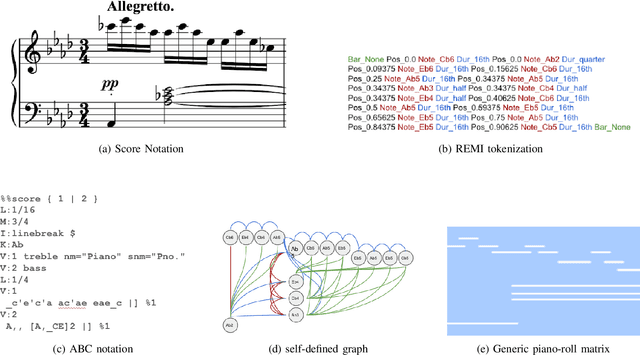
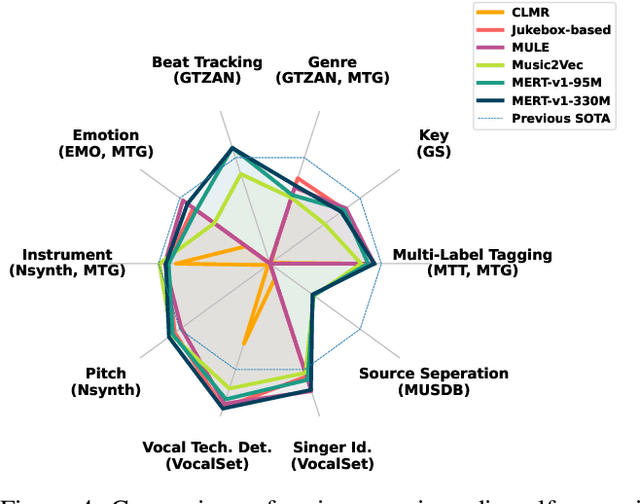
Abstract:In recent years, foundation models (FMs) such as large language models (LLMs) and latent diffusion models (LDMs) have profoundly impacted diverse sectors, including music. This comprehensive review examines state-of-the-art (SOTA) pre-trained models and foundation models in music, spanning from representation learning, generative learning and multimodal learning. We first contextualise the significance of music in various industries and trace the evolution of AI in music. By delineating the modalities targeted by foundation models, we discover many of the music representations are underexplored in FM development. Then, emphasis is placed on the lack of versatility of previous methods on diverse music applications, along with the potential of FMs in music understanding, generation and medical application. By comprehensively exploring the details of the model pre-training paradigm, architectural choices, tokenisation, finetuning methodologies and controllability, we emphasise the important topics that should have been well explored, like instruction tuning and in-context learning, scaling law and emergent ability, as well as long-sequence modelling etc. A dedicated section presents insights into music agents, accompanied by a thorough analysis of datasets and evaluations essential for pre-training and downstream tasks. Finally, by underscoring the vital importance of ethical considerations, we advocate that following research on FM for music should focus more on such issues as interpretability, transparency, human responsibility, and copyright issues. The paper offers insights into future challenges and trends on FMs for music, aiming to shape the trajectory of human-AI collaboration in the music realm.
Music ControlNet: Multiple Time-varying Controls for Music Generation
Nov 13, 2023



Abstract:Text-to-music generation models are now capable of generating high-quality music audio in broad styles. However, text control is primarily suitable for the manipulation of global musical attributes like genre, mood, and tempo, and is less suitable for precise control over time-varying attributes such as the positions of beats in time or the changing dynamics of the music. We propose Music ControlNet, a diffusion-based music generation model that offers multiple precise, time-varying controls over generated audio. To imbue text-to-music models with time-varying control, we propose an approach analogous to pixel-wise control of the image-domain ControlNet method. Specifically, we extract controls from training audio yielding paired data, and fine-tune a diffusion-based conditional generative model over audio spectrograms given melody, dynamics, and rhythm controls. While the image-domain Uni-ControlNet method already allows generation with any subset of controls, we devise a new strategy to allow creators to input controls that are only partially specified in time. We evaluate both on controls extracted from audio and controls we expect creators to provide, demonstrating that we can generate realistic music that corresponds to control inputs in both settings. While few comparable music generation models exist, we benchmark against MusicGen, a recent model that accepts text and melody input, and show that our model generates music that is 49% more faithful to input melodies despite having 35x fewer parameters, training on 11x less data, and enabling two additional forms of time-varying control. Sound examples can be found at https://MusicControlNet.github.io/web/.
 Add to Chrome
Add to Chrome Add to Firefox
Add to Firefox Add to Edge
Add to Edge